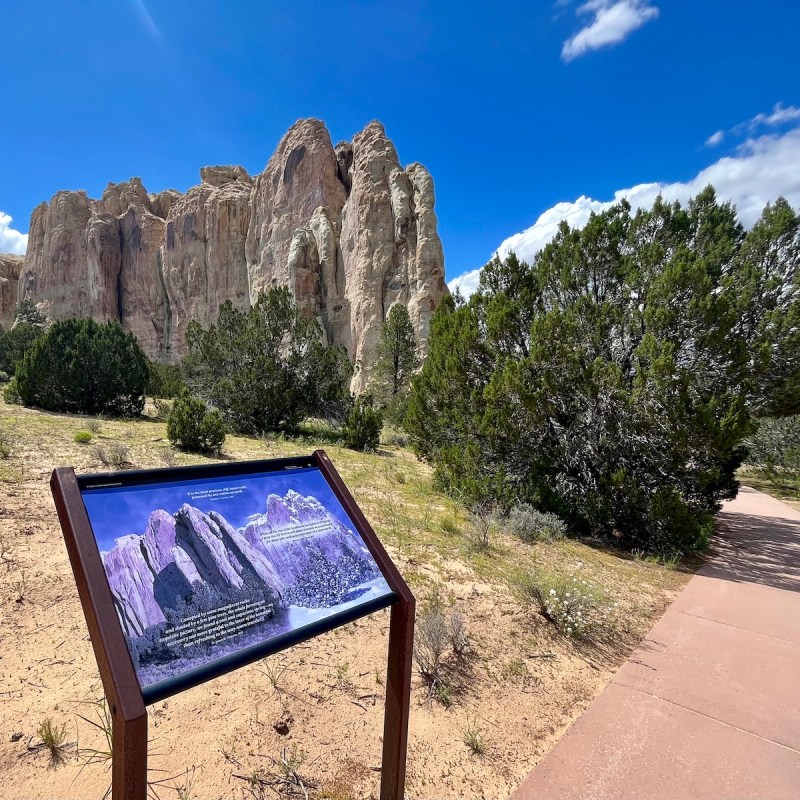
El Morro National Monument’s massive sandstone bluff is spectacular in and of itself, but it is what is etched on the walls of stone that sets this New Mexico monument apart. Look closely as you walk the trails, and you will spot hundreds of messages that echo through the ages.
Videos by TravelAwaits
Perhaps what is most remarkable about El Morro National Monument is the range of the rock carvings. Side-by-side on the sandstone walls are centuries-old etchings by the Zuni people, messages from the Spanish conquistadors of the 1500s, and names and dates carved by the immigrants and armies that passed through in the 1800s as part of the westward expansion of the United States.
The area was designated a national monument by President Theodore Roosevelt in 1906, after which further carving was prohibited by law. What remains is a unique story that runs from the late 1200s through the early 1900s.
Here are seven fascinating things to do at El Morro National Monument.

1. Cuesta
One of the joys of visiting El Morro is the view as you approach from the west or the east. The national monument describes the large rock formation as a cuesta, a long formation that gently slopes upward and then drops off abruptly at one end. To some, El Morro has the appearance of a giant ocean liner streaming through the desert.
As I approached on a late-summer road trip, the rock formation was set off by colorful wildflowers and green grass waving in the breeze. It is definitely worth stopping at one of the turnouts along Highway 53 to take in the splendor of the rock that has been called various names over the centuries, starting with Atsinna (a place of writings on the rock) by the Zuni people, El Morro (the headland) by the Spaniards, and Inscription Rock by the Anglo-Americans.

2. Inscription Wall’s Messages
As I walked the peaceful Inscription Rock Trail and studied the inscriptions carved into the massive rock walls, I couldn’t help but feel a connection to those long-ago travelers, some of whom added simple messages such as pasó por aqui (passed by here), and others who added names and dates.
In all, there are more than 2,000 carvings at the base of the sandstone promontory. Each petroglyph, signature, date, and message inscribed at El Morro “has a unique and significant story to tell about the peoples of different cultures who were there,” says the national monument’s website.
The Inscription Rock Trail also passes by one of the features that have attracted travelers for centuries — the pool of runoff and snowmelt that forms at the shady base of the rock wall. Early travelers relied on the source of water and El Morro became known as a stopping-off point. When I visited in late August, the pool was filled with cattails and tall native grasses.
The Inscription Rock Trail is a paved half-mile loop that is rated as easy and wheelchair accessible with assistance. It takes about a half-hour to complete.
Pro Tip: The rock carvings of the names “Breckenridge” and “Beale” recall two of the men involved in an 1850s experiment by the U.S. Army to bring camels to the area to try to solve the water-supply problem on the westward expansion route from the Mississippi River to California through the Southwestern desert. The national monument regularly commemorates that experiment with its biennial event, the Camel Corp Commemoration.

3. The Headland Trail
Beautiful views of El Morro’s broad rock wall, the Zuni Mountains, and the volcanic craters of the El Malpais area are in store by continuing from the Inscription Trail to the Headland Trail.
The trail becomes a bit more difficult after leaving the paved Inscription Rock section. The Headland Trail, which is rated as moderate to strenuous, includes several staircases, rocky climbs, and a 250-foot elevation gain. Sturdy walking shoes and water, particularly in the hot summer months, are necessary.

After traversing several staircases that lead to more inscriptions in the rocks, the Headland Trail continues into a beautiful meadow, which was dotted with colorful wildflowers when I visited. The trail soon begins to rise again and at one point traverses a set of stairs carved into the sandstone.
The 2-mile Headlands Trail loop takes an hour to complete.
Pro Tip: Portions or all of the Headland Trail can be closed during the winter (December through April) due to ice and snow.

4. An Ancestral Puebloan Dwelling At Atsinna
Along with stunning vistas of the surrounding terrain, the Headlands Trail also passes by a scenic box canyon before reaching the ruins of the Atsinna Pueblo, a 355-room dwelling that dates back to about 1275 AD.
The location of the pueblo was considered strategic for two reasons. First, it was near the only water source for many miles around, and second, it offered protection because it was located at the top of a nearly impenetrable bluff.
The pueblo was occupied until about 1350 AD. It was partially evacuated in the 1950s, and masons and archaeologists continue to work toward its stabilization.
For hikers, Atsinna offers a fascinating reward for the Headland Trail’s steep climb.

5. The Visitor Center
More than 700 years of human history are on display at El Morro’s informative visitor center — the recommended first stop for visitors to the national monument.
The visitor center is a relic in its own right. The rustic rock-and-wood building was completed in 1964 as a part of the Mission 66 effort — a 10-year program created to revitalize the national parks in time for the 50th anniversary of the National Park Service in 1966.
With both of El Morro’s main hiking trails starting at the visitor center, the building is a great place to begin and end an exploration of the national monument. The interior features educational displays and a well-stocked gift shop. It also offers a 15-minute video that tells El Morro’s cultural and natural history.

6. Ancient Way Café
Just a five-minute drive from El Morro National Monument is the scenic Ancient Way Café, a homey restaurant that offers New Mexico-style breakfasts, lunches, espressos, and bakery items. The Ancient Way, which is billed as a healing spot along Highway 53, is known for high-quality ingredients, including hormone-free beef from the family-owned ranch.
Menu items include local breakfast favorites like huevos rancheros featuring three corn tortillas smothered in refried beans, red or green chili, and melted cheddar topped with two eggs. Lunch items include a brisket sandwich filled with beef smoked and slow-cooked on-site and served with barbecue sauce or apricot habanero sauce. The café also has a bakery that turns out made-from-scratch scones, cinnamon buns, and strudels.
Pro Tip: Along with the café, the Ancient Way is the home of the El Morro RV Park & Cabins, which offers full-hookup RV sites, shady tent sites, large and small cabins, and winter cabins.

7. The Trail Of Ancients
Another fascinating stop on New Mexico’s Trail of Ancients is located about 40 miles west of El Morro at the Zuni Pueblo, a community of about 12,500 people with a unique language, culture, and history.
A visit to both the Atsinna Pueblo ruins on the top of the El Morro headland and the Zuni Pueblo offers insight into the ancient progression of the native people. After they left the Atsinna Pueblo, the native Puebloan people are said to have moved to larger, consolidated villages in the Zuni Valley, including the Zuni Pueblo, the largest of the 19 New Mexican pueblos.
About 80 percent of the Zuni Pueblo’s workforce is involved in the arts, creating traditional inlay silverwork, stone fetish carving, and pottery. Visitors will find numerous authentic art shops, such as the All Tribes Jewelry & Art, located along Zuni’s main street.
Spanish explorers first encountered the Zuni Pueblo in 1540 during their search for the legendary Seven Golden Cities of Cibola. Today, tours are available for several of the pueblo’s ancient sites, including the Middle Village and the Village of the Great Kivas.
Where El Morro National Monument Is Located
Located about two and a half hours southwest of Albuquerque and an hour southeast of Gallup, El Morro National Monument is one of many prehistoric sites on New Mexico’s Trail of Ancients Byway.
Tucked away in the far southern reaches of the byway, El Morro retains the feel of an off-the-beaten-path destination. In 2019, fewer than 70,000 people visited El Morro. When I happened upon the national monument during a recent visit to the nearby Zuni Pueblo, I had the trails virtually to myself. A ranger in the visitor center told me that El Morro is considered a hidden gem among New Mexico’s national monuments and parks, and I wholeheartedly agree.
When To Visit El Morro National Monument
With an elevation of more than 7,000 feet, El Morro is known for warm days and cool nights from late spring to early fall, and chilly days and nights in the winter months. June, July, and August post average highs in the mid-80-degree Fahrenheit range and average lows in the 40s and 50s. Spring and fall are also beautiful times to visit, with April and May experiencing average highs in the 60-to-70-degree range and nights in the 30s and 40s. September and October post similar average temperatures. From December through February, daytime highs average in the 40s, and nights drop into the 14-to-18-degree range.
For more information on traveling to New Mexico, check out these articles:
